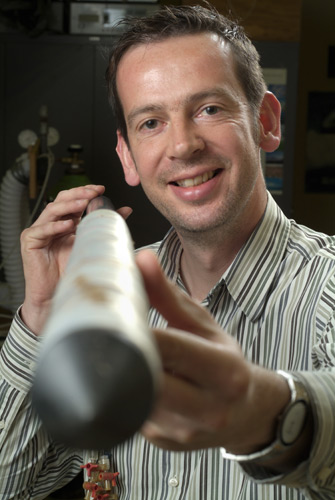
Peepers and colloquially named “rockets” may not sound overly scientific. But they’re among the instruments used by a Guelph scientist to help understand how substances moving among air, ground and water affect the health of ecosystems and people around the world.
Getting the big picture on Earth’s natural cycles is what interests Prof. Christian Blodau, School of Environmental Sciences. That big picture is also captured in the title of his Canada Research Chair in Environmental Geology and Biogeochemistry, which he assumed last fall upon arriving in Guelph from his native Germany.
Whether you’re looking to help clean up contaminated soil and water or studying how carbon is trapped or released from the world’s peatlands, “you need to understand how the cycle functions and where it’s regulated if you want to make predictions,” he says.
Blodau aims to help refine scientific models to describe how elements and compounds in the air, earth and water move about.
“We can measure environmental cycling. We can quantify fluxes between soil and the atmosphere, soil and groundwater, groundwater and surface water. We know elements are cycled in the environment, but we lack a theoretical framework to understand how rapidly these elements cycle.”
Which elements? Carbon and nitrogen cycles are big, complicated and important, he says. At Guelph, he has applied for funding to continue studies of how the world’s wetlands, including peatlands, store and release carbon and methane.
Boreal forests hold up to 40 per cent of the world’s terrestrial carbon, mostly stored in peat. More scientists are sounding alarm bells about climate change possibly unlocking much of that carbon from warming peatlands and adding yet more greenhouse gases to the atmosphere.
Blodau is interested in seeing how and why elements like carbon are stored in the first place and how environmental change might affect that storage. While completing his PhD at McGill University, he looked at how drought affects release of carbon dioxide and methane. Much of that work happened at the Mer Bleue bog near Ottawa.
Having looked this year at wetlands around Punta Arenas in southern Chile, he travelled to the Netherlands this spring for a project on nitrogen and carbon cycles in peat bogs across northern Europe. There his work might help government agencies better understand threats posed by nitrogen pollution on wetland function and the ecosystem services provided by those wetlands.
His work has taken him to Siberia, Colorado and the United Kingdom. Here in Canada, he also plans to study carbon sequestration in the Hudson Bay lowlands.
In his Richards Building office, Blodau shows off his field instrument collection. A pore water peeper resembling an oversized see-through computer keyboard allows him to study gas concentration in soil water.
Another instrument like a waist-high “rocket” is driven point-down into soil to collect information about subsurface chemicals. Much like a geologist reading past events in a drilled-out sediment core, “I look at the present concentration of elements and calculate from these data what is currently going on,” he says.
A chemistry graduate of the University of Bonn, Blodau studied environmental science at the University of Bayreuth and Indiana University before completing his PhD at McGill. Most recently, he was a researcher at Bayreuth.